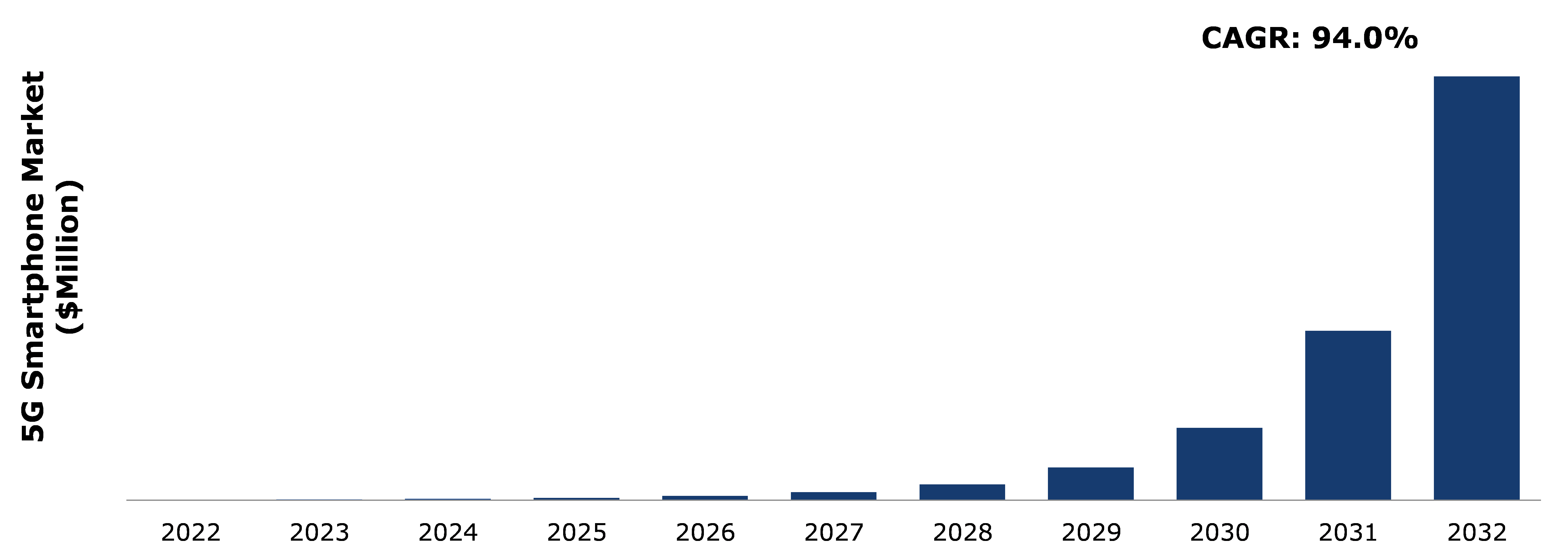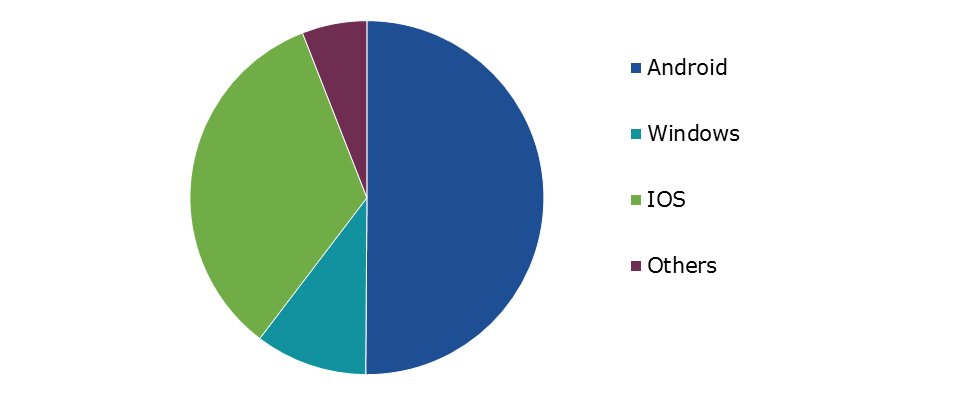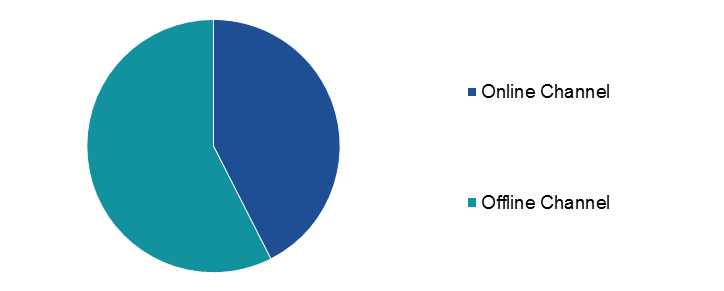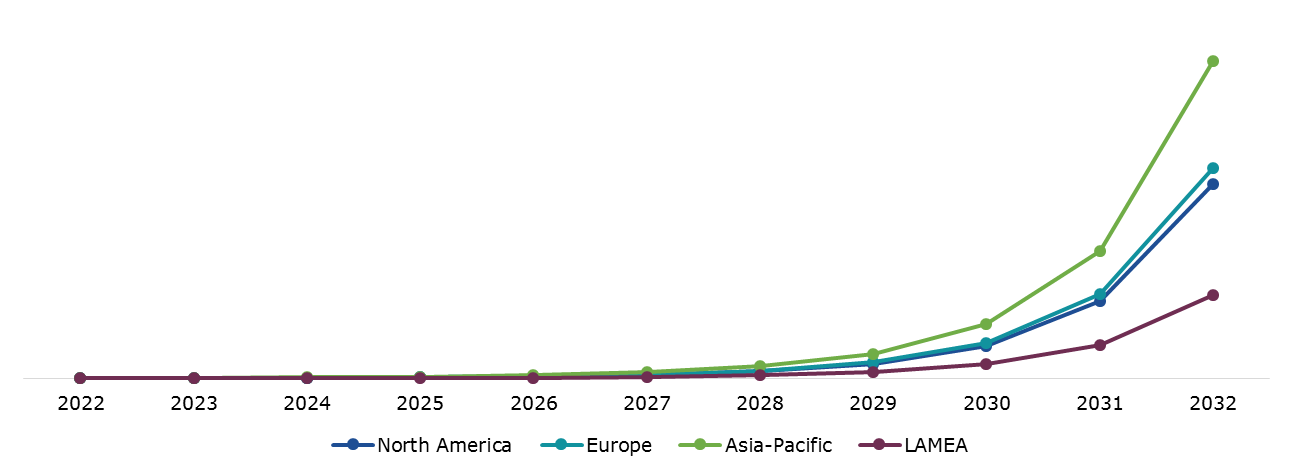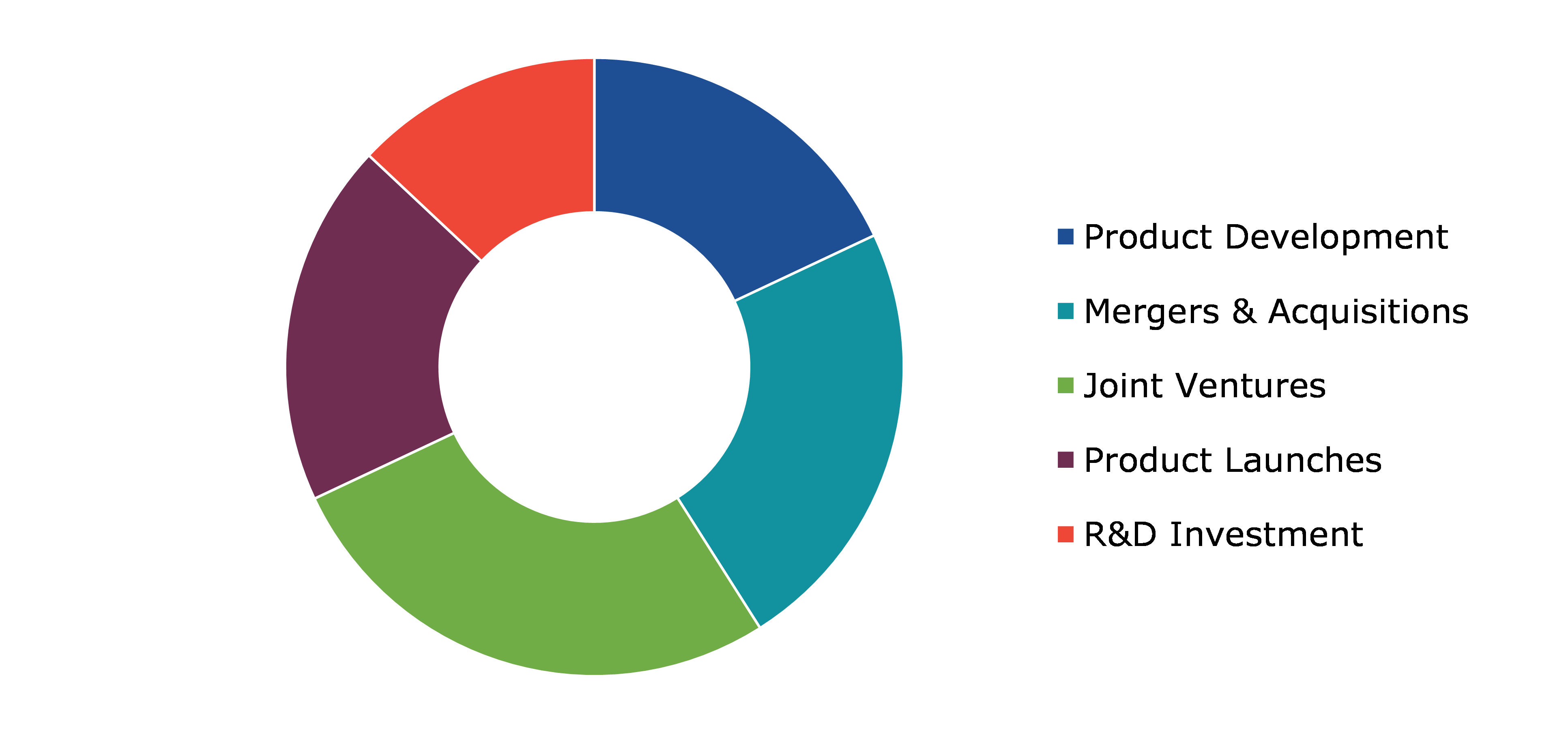Global 5G Smart Phones Market Report
RA08560
Global 5G Smart Phones Market by Operating System (Android, Windows, IOS, and Others), Sales Channel (Offline Channel and Offline Channel), and Region (North America, Europe, Asia-Pacific, and LAMEA): Opportunity Analysis and Industry Forecast, 2023-2032
5G Smart Phones Overview
5G smart phones are the latest generation of mobile devices that support fifth-generation wireless technology, commonly known as 5G. These smart phones are designed to take advantage of the faster speeds, lower latency, and increased network capacity offered by 5G networks 5G smart phones are capable of connecting to 5G networks, which provide significantly faster download and upload speeds compared to previous generations. With 5G, users can experience smoother streaming, faster downloads, and quicker response times for online gaming and other data-intensive activities. 5G networks offer substantially higher data rates compared to 4G LTE. While the actual speeds may vary depending on network conditions and congestion, 5G can deliver peak download speeds of several gigabits per second (Gbps), enabling rapid data transfer and streaming of high-quality multimedia content. The fifth-generation smart phones give users access to high-speed networks and a faster data transfer experience.
5G smartphone is device designed to pass information from one system to another. 5G Smart phones are also used to provide remote access to systems and exchange files and messages in text, audio and/or video formats between different computers or users. This includes terminal emulators, file transfer programs, chat and instant messaging programs, as well as similar functionality integrated within MUDs. Most communication software solutions can be accessed using a smartphone or tablet, considerably reducing hardware costs.
Global 5G Smart Phones Market Analysis
The Global 5G Smart Phones Market Size was $18,040.00 million in 2022 and is predicted to grow with a CAGR of 94.0%, by generating a revenue of $13,633,254.80 million by 2032.
Source: Research Dive Analysis
COVID-19 Impact on Global 5G Smart Phones Market
The COVID-19 pandemic has a considerable impact on the 5G smart phones market. The development of the 5G smartphone market has also been hampered by COVID-19. Since the industry experienced a scarcity of 5G chipsets as a result of the interruption to production and the stoppage of manufacturing activities. The pandemic led to disruptions in global supply chains, including the production and distribution of 5G smart phones. Many manufacturing facilities had to temporarily shut down or reduce their operations, affecting the availability of 5G devices in the market. Moreover, economic uncertainties and lockdown measures in various countries led to a decline in consumer spending. People prioritized essential goods and services over discretionary purchases, including smart phones. This overall decrease in consumer spending negatively impacted the demand for 5G smart phones. The market for 5G smart phones is predicted to grow rapidly following the pandemic because of the development of numerous technologies as well as the rising need for high-speed data access. The pandemic accelerated the adoption of remote work, distance learning, and online activities. This increased the demand for reliable and high-speed internet connectivity, driving the need for 5G-enabled devices, including smart phones. As a result, some individuals and businesses opted to upgrade to 5G smart phones to leverage the benefits of faster internet speeds and improved connectivity.
Growing Demand for 5G Technology in Phones to Drive the Market Growth
The ability to provide high-speed internet connectivity, coverage, and reliability in comparison to its 4G-based smart phones, new product launches by 5G-enabled smartphone manufacturers, and a sizable untapped market in the emerging economies, particularly China and India, are the factors boosting the overall market growth. Increased mobile broadband, dependable low latency communication, a high level of security, and power efficiency are the main functional factors promoting market growth. Moreover, the rise in the usage of 5G smart phones contributes to the development of an ecosystem of interconnected devices and services. As more consumers adopt 5G devices, the demand for complementary products and services such as IoT devices, cloud services, and streaming platforms increases. Smartphone manufacturers can leverage this trend by collaborating with other companies to create a seamless and interconnected ecosystem that enhances the user experience and drives further adoption of 5G technology.
To know more about global 5G smart phones market drivers, get in touch with our analysts here.
High Cost of 5G Smart Phones to Restrain the Market Growth
The cost of 5G smart phones is typically higher than that of 4G devices, which may prevent some consumers from adopting them, especially in developing markets. As more manufacturers enter the 5G smart phones market, pricing may decrease as a result of increased competition. The is especially true in developing markets where consumer purchasing decisions are heavily influenced by affordability.
Increased Device Adoption of 5G Smart Phones to Drive Excellent Opportunities
The main factor facilitating the adoption of 5G smart phones is the developments in fog computing. Due to the increasing usage of smart phones in daily life, mobile data traffic has increased dramatically. In this case, 5G network operators face a significant challenge in providing users with a service that is guaranteed to be effective. An effective, customized service for dedicated mobile traffic is fog computing. It investigates patterns of network provider demand and accordingly offers specialized short-distance local network connections and localized services. The advent of 5G technology provides an opportunity for smartphone manufacturers to innovate and push the boundaries of what smart phones can do. With faster network speeds and lower latency, 5G enables new possibilities such as augmented reality (AR), virtual reality (VR), and enhanced gaming experiences. Manufacturers can leverage these capabilities to develop innovative features and applications that capitalize on the benefits of 5G connectivity. The increased device adoption of 5G smart phones presents a promising market opportunity for smartphone manufacturers. By offering a diverse range of 5G-compatible devices and leveraging the capabilities of 5G technology, manufacturers can drive sales, differentiate themselves, and contribute to the growth of the 5G ecosystem.
To know more about global 5G smart phones market opportunities, get in touch with our analysts here.
Global 5G Smart Phones Market Share, by Operating System, 2022
Source: Research Dive Analysis
The Android sub-segment accounted for the highest market share in 2022. Affordability and compatibility with a wide range of applications, and ease of use are the main drivers of the growth of the segment. The most recent Android-based devices also have the capability to manage multiple tasks, are enabled with sensors, and offer various security advantages like fingerprint phone unlocking. These elements give this operating system an advantage over competing ones. Android is an open-source operating system, which means that smartphone manufacturers can easily customize and integrate it into their devices. This flexibility allows manufacturers to offer a wide range of Android-based smart phones with different features, designs, and price points, catering to diverse consumer preferences. Furthermore, android has a vast ecosystem of apps available through the Google Play Store. This extensive app library offers a wide variety of applications and services, including social media, entertainment, productivity, and gaming, among others. Consumers can easily find and download apps that suit their needs, enhancing the overall user experience of Android-based 5G smart phones.
Global 5G Smart Phones Market Size, by Sales Channel, 2022
Source: Research Dive Analysis
The online channel sub-segment accounted for the highest market share in 2022. The online channel is expected to expand as a result of a number of factors, including e-commerce platforms that enable customers to shop whenever and wherever they want. Online stores also provide excellent discounts and a wide range of brands in one location, making it simple for customers to choose the smart phones they want. Among others, Flipkart, Amazon, and the Apple Store are major players in the e-commerce sector. The increasing availability and affordability of internet access worldwide has led to a significant rise in online shopping. As more people gain access to the internet, they are increasingly relying on online channels to purchase smart phones, including 5G smart phones. Moreover, online channels offer a wide range of 5G smart phones from various brands and models. Consumers can easily access a comprehensive selection of smart phones, compare specifications and features, and choose the one that best meets their requirements. This extensive product range attracts consumers to online channels.
Global 5G Smart Phones Market Size & Forecast, by Region, 2022-2032 ($Million)
Source: Research Dive Analysis
The Asia-Pacific 5G smart phones market generated the highest revenue in 2022. Asia-Pacific is known for its highly advanced technology and infrastructure. The rapid adoption of 5G networks in the Asia-Pacific is largely the reason for the market expansion in the Asia-Pacific region. This is also driving demand for smart phones with high-speed data transfer capabilities and expected to increase demand for 5G smart phones in the near future. In the near future, the Asia Pacific region's 5G smart phones market is expected to be driven by the rising demand for premium smart phones as well as high consumer disposable income. Over the forecast period, rising demand for technologically advanced smart phones will drive the market for 5G smart phones.
Competitive Scenario in the Global 5G Smart Phones Market
Investment and agreement are common strategies followed by major market players. Huawei Technologies Co., Ltd. is a multinational technology company and offers a wide range of products and services across multiple sectors, including telecommunications equipment, smart phones, tablets, wearable devices, laptops, cloud computing, data centers, enterprise networking solutions, and more. Huawei's product portfolio includes mobile networks, broadband networks, IP-based products, optical networks, and software-defined networking solutions. Huawei is known for its expertise in telecommunications infrastructure. It provides equipment and solutions for mobile networks, fixed networks, and carrier software to telecommunication operators worldwide. Huawei's products enable the deployment of 5G, 4G LTE, and other network technologies. In September 2019, the "HUAWEI Mate 30" smartphone series was introduced by Huawei Device Co., Ltd. in Munich. The renowned series includes a top Kirin 990 5G SoC, a quad camera system with a futuristic halo ring design, and a super sensing cone camera.
Source: Research Dive Analysis
Some of the leading 5G smart phones market players are Samsung Electronics Co.Ltd., Huawai Technologies Co.Ltd., Motorola.Inc., Apple Inc., TCLCommunication Limited, LG Electronics Inc., Xiaomi Corporation, Nokia Corporation, Lenovo Group Limited, and BBK Electronics Ltd.
| Aspect | Particulars |
| Historical Market Estimations | 2020-2022 |
| Base Year for Market Estimation | 2023 |
| Forecast Timeline for Market Projection | 2023-2032 |
| Geographical Scope | North America, Europe, Asia-Pacific, and LAMEA |
| Segmentation by Operating System |
|
| Segmentation by Sales Channel |
|
| Key Companies Profiled |
|
Q1. What is the size of the global 5G smart phones market?
A. The size of the global 5G Smart phones market was over $18,040.00 million in 2022 and is projected to reach $13,633,254.80 million by 2032.
Q2. Which are the major companies in the 5G smart phones market?
A. Samsung Electronics Co.Ltd., Huawai Technologies Co.Ltd., Motorola.Inc., Apple Inc., TCLCommunication Limited, LG Electronics Inc., Xiaomi Corporation, Nokia Corporation, Lenovo Group Limited, and BBK Electronics Ltd. are some of the key players in the global 5G Smart phones market.
Q3. Which region, among others, possesses greater investment opportunities in the near future?
A. The Asia-Pacific region possesses great investment opportunities for investors to witness the most promising growth in the future.
Q4. What will be the growth rate of the Asia-Pacific 5G smart phones market?
A. Asia-Pacific 5G smart phones market is anticipated to grow at 3.1% CAGR during the forecast period.
Q5. What are the strategies opted by the leading players in this market?
A. Agreement and investment are the two key strategies opted by the operating companies in this market.
Q6. Which companies are investing more on R&D practices?
A. Samsung Electronics Co.Ltd., Huawai Technologies Co.Ltd. and Motorola.Inc. are the companies investing more on R&D activities for developing new products and technologies.
1.Research Methodology
1.1.Desk Research
1.2.Real time insights and validation
1.3.Forecast model
1.4.Assumptions and forecast parameters
1.5.Market size estimation
1.5.1.Top-down approach
1.5.2.Bottom-up approach
2.Report Scope
2.1.Market definition
2.2.Key objectives of the study
2.3.Report overview
2.4.Market segmentation
2.5.Overview of the impact of COVID-19 on Global 5G smart phone market
3.Executive Summary
4.Market Overview
4.1.Introduction
4.2.Growth impact forces
4.2.1.Drivers
4.2.2.Restraints
4.2.3.Opportunities
4.3.Market value chain analysis
4.3.1.List of raw material suppliers
4.3.2.List of manufacturers
4.3.3.List of distributors
4.4.Innovation & sustainability matrices
4.4.1.Technology matrix
4.4.2.Regulatory matrix
4.5.Porter’s five forces analysis
4.5.1.Bargaining power of suppliers
4.5.2.Bargaining power of consumers
4.5.3.Threat of substitutes
4.5.4.Threat of new entrants
4.5.5.Competitive rivalry intensity
4.6.PESTLE analysis
4.6.1.Political
4.6.2.Economical
4.6.3.Social
4.6.4.Technological
4.6.5.Environmental
4.7.Impact of COVID-19 on 5G smart phone market
4.7.1.Pre-covid market scenario
4.7.2.Post-covid market scenario
5.5G Smart Phone Market Analysis, by Operating System
5.1.Overview
5.2.Android
5.2.1.Definition, key trends, growth factors, and opportunities
5.2.2.Market size analysis, by region, 2022-2032
5.2.3.Market share analysis, by country, 2022-2032
5.3.Windows
5.3.1.Definition, key trends, growth factors, and opportunities
5.3.2.Market size analysis, by region, 2022-2032
5.3.3.Market share analysis, by country, 2022-2032
5.4.IOS
5.4.1.Definition, key trends, growth factors, and opportunities
5.4.2.Market size analysis, by region, 2022-2032
5.4.3.Market share analysis, by country, 2022-2032
5.5.Others
5.5.1.Definition, key trends, growth factors, and opportunities
5.5.2.Market size analysis, by region, 2022-2032
5.5.3.Market share analysis, by country, 2022-2032
5.6.Research Dive Exclusive Insights
5.6.1.Market attractiveness
5.6.2.Competition heatmap
6.5G Smart Phone Market Analysis, by Sales Channel
6.1.Offline Channel
6.1.1.Definition, key trends, growth factors, and opportunities
6.1.2.Market size analysis, by region, 2022-2032
6.1.3.Market share analysis, by country, 2022-2032
6.2.Online Channel
6.2.1.Definition, key trends, growth factors, and opportunities
6.2.2.Market size analysis, by region, 2022-2032
6.2.3.Market share analysis, by country, 2022-2032
6.3.Research Dive Exclusive Insights
6.3.1.Market attractiveness
6.3.2.Competition heatmap
7.5G Smart Phone Market, by Region
7.1.North America
7.1.1.U.S.
7.1.2.Market size analysis, by Operating System, 2022-2032
7.1.3.Market size analysis, by Sales Channel, 2022-2032
7.1.4.Canada
7.1.5.Market size analysis, by Operating System, 2022-2032
7.1.6.Market size analysis, by Sales Channel, 2022-2032
7.1.7.Mexico
7.1.8.Market size analysis, by Operating System, 2022-2032
7.1.9.Market size analysis, by Sales Channel, 2022-2032
7.1.10.Research Dive Exclusive Insights
7.1.10.1.Market attractiveness
7.1.10.2.Competition heatmap
7.2.Europe
7.2.1.Germany
7.2.2.Market size analysis, by Operating System, 2022-2032
7.2.3.Market size analysis, by Sales Channel, 2022-2032
7.2.4.UK
7.2.5.Market size analysis, by Operating System, 2022-2032
7.2.6.Market size analysis, by Sales Channel, 2022-2032
7.2.7.France
7.2.8.Market size analysis, by Operating System, 2022-2032
7.2.9.Market size analysis, by Sales Channel, 2022-2032
7.2.10.Spain
7.2.11.Market size analysis, by Operating System, 2022-2032
7.2.12.Market size analysis, by Sales Channel, 2022-2032
7.2.13.Italy
7.2.14.Market size analysis, by Operating System, 2022-2032
7.2.15.Market size analysis, by Sales Channel, 2022-2032
7.2.16.Rest of Europe
7.2.17.Market size analysis, by Operating System, 2022-2032
7.2.18.Market size analysis, by Sales Channel, 2022-2032
7.2.19.Research Dive Exclusive Insights
7.2.19.1.Market attractiveness
7.2.19.2.Competition heatmap
7.3.Asia Pacific
7.3.1.China
7.3.2.Market size analysis, by Operating System, 2022-2032
7.3.3.Market size analysis, by Sales Channel, 2022-2032
7.3.4.Japan
7.3.5.Market size analysis, by Operating System, 2022-2032
7.3.6.Market size analysis, by Sales Channel, 2022-2032
7.3.7.India
7.3.8.Market size analysis, by Operating System, 2022-2032
7.3.9.Market size analysis, by Sales Channel, 2022-2032
7.3.10.Australia
7.3.11.Market size analysis, by Operating System, 2022-2032
7.3.12.Market size analysis, by Sales Channel, 2022-2032
7.3.13.South Korea
7.3.14.Market size analysis, by Operating System, 2022-2032
7.3.15.Market size analysis, by Sales Channel, 2022-2032
7.3.16.Rest of Asia Pacific
7.3.17.Market size analysis, by Operating System, 2022-2032
7.3.18.Market size analysis, by Sales Channel, 2022-2032
7.3.19.Research Dive Exclusive Insights
7.3.19.1.Market attractiveness
7.3.19.2.Competition heatmap
7.4.LAMEA
7.4.1.Brazil
7.4.2.Market size analysis, by Operating System, 2022-2032
7.4.3.Market size analysis, by Sales Channel, 2022-2032
7.4.4.Saudi Arabia
7.4.5.Market size analysis, by Operating System, 2022-2032
7.4.6.Market size analysis, by Sales Channel, 2022-2032
7.4.7.UAE
7.4.8.Market size analysis, by Operating System, 2022-2032
7.4.9.Market size analysis, by Sales Channel, 2022-2032
7.4.10.South Africa
7.4.11.Market size analysis, by Operating System, 2022-2032
7.4.12.Market size analysis, by Sales Channel, 2022-2032
7.4.13.Rest of LAMEA
7.4.14.Market size analysis, by Operating System, 2022-2032
7.4.15.Market size analysis, by Sales Channel, 2022-2032
7.4.16.Research Dive Exclusive Insights
7.4.16.1.Market attractiveness
7.4.16.2.Competition heatmap
8.Competitive Landscape
8.1.Top winning strategies, 2022
8.1.1.By strategy
8.1.2.By year
8.2.Strategic overview
8.3.Market share analysis, 2022
9.Company Profiles
9.1.SAMSUNG ELETRONICS Co Ltd,
9.1.1.Overview
9.1.2.Business segments
9.1.3.Product portfolio
9.1.4.Financial performance
9.1.5.Recent developments
9.1.6.SWOT analysis
9.2.Huawai Technologies CO..LTD
9.2.1.Overview
9.2.2.Business segments
9.2.3.Product portfolio
9.2.4.Financial performance
9.2.5.Recent developments
9.2.6.SWOT analysis
9.3.Motorola,inc.
9.3.1.Overview
9.3.2.Business segments
9.3.3.Product portfolio
9.3.4.Financial performance
9.3.5.Recent developments
9.3.6.SWOT analysis
9.4.Apple INC
9.4.1.Overview
9.4.2.Business segments
9.4.3.Product portfolio
9.4.4.Financial performance
9.4.5.Recent developments
9.4.6.SWOT analysis
9.5.TCLCommunication Limited
9.5.1.Overview
9.5.2.Business segments
9.5.3.Product portfolio
9.5.4.Financial performance
9.5.5.Recent developments
9.5.6.SWOT analysis
9.6.LG Electronos INC
9.6.1.Overview
9.6.2.Business segments
9.6.3.Product portfolio
9.6.4.Financial performance
9.6.5.Recent developments
9.6.6.SWOT analysis
9.7.Xiaomi Coporation
9.7.1.Overview
9.7.2.Business segments
9.7.3.Product portfolio
9.7.4.Financial performance
9.7.5.Recent developments
9.7.6.SWOT analysis
9.8.Nokia Coporation
9.8.1.Overview
9.8.2.Business segments
9.8.3.Product portfolio
9.8.4.Financial performance
9.8.5.Recent developments
9.8.6.SWOT analysis
9.9.Lenovo Group Limited
9.9.1.Overview
9.9.2.Business segments
9.9.3.Product portfolio
9.9.4.Financial performance
9.9.5.Recent developments
9.9.6.SWOT analysis
9.10.bbk Electronic LTD
9.10.1.Overview
9.10.2.Business segments
9.10.3.Product portfolio
9.10.4.Financial performance
9.10.5.Recent developments
9.10.6.SWOT analysis
5G smartphones are the latest generation of mobile devices designed to leverage the power of fifth-generation wireless technology. These devices can access and harness the incredible speed and low latency offered by 5G networks. With advanced network architecture and optimized hardware, 5G smartphones are built to deliver faster data transfer rates, seamless streaming, and enhanced overall performance. The primary advantage of 5G smartphones is their ability to achieve unparalleled speeds. This can enable users to enjoy ultra-fast internet connectivity, allowing for quick downloads, smooth streaming of high-definition content, and seamless online gaming experiences. Moreover, 5G smartphones offer significantly reduced latency compared to previous generations. This is particularly beneficial for applications such as video conferencing, cloud gaming, and augmented reality (AR) experiences.
Forecast Analysis of the 5G Smart Phones Market
The increasing demand for 5G technology in phones to provide high-speed internet connectivity, coverage, and reliability in comparison to 4G-based smartphones is expected to bolster the growth of the global 5G smart phones market over the estimated timeframe. Moreover, leading manufacturers are offering a wide range of 5G-compatible devices and leveraging the capabilities of 5G technology which is expected to create massive growth opportunities for the market during the analysis timeframe. However, the high cost of 5G smartphones may hinder the growth of the market throughout the forecast timeframe.
According to the report published by Research Dive, the global 5G smart phones market is projected to generate a revenue of $13,633,254.80 million and grow at a CAGR of 94.0% over the analysis timeframe from 2022 to 2032. The major players of the market include LG Electronics Inc., TCLCommunication Limited, Xiaomi Corporation, Apple Inc., Nokia Corporation, Motorola.Inc., Lenovo Group Limited, Huawei Technologies Co.Ltd., BBK Electronics Ltd., Samsung Electronics Co.Ltd., and many more.
5G Smart Phones Market Key Trends & Developments
The key companies operating in the industry are adopting various growth strategies & business tactics such as partnerships, collaborations, mergers & acquisitions, and launches to maintain a robust position in the overall market, which is subsequently helping the global 5G smart phones market to grow exponentially. For instance:
- In January 2023, Nokia Corporation, a leading Finnish multinational telecommunications, IT, and consumer electronics corporation announced that it has signed a new cross-license patent agreement with Samsung to promote Nokia’s fundamental inventions in 5G and other technologies. In this agreement, Samsung would make payments to Nokia for a multi-year period.
- In February 2023, Vodafone Idea (Vi), a leading Indian mobile network operator announced its partnership with Motorola, a renowned smartphone maker. This partnership would help Motorola ensure seamless 5G connectivity across its 5th-generation smartphones.
- In February 2023, DISH Wireless, an American wireless network provider announced the launch of its virtual open RAN 5G network with Samsung, a South Korean multinational manufacturing conglomerate. This would accelerate the DISH network deployment across the U.S. to provide reliable and fast nationwide coverage to DISH wireless network users.
Most Profitable Region
The Asia-Pacific region of the 5G smart phones market held the largest share of the market in 2022. This is majorly due to the rapid adoption of 5G networks across the region. Additionally, the growing demand for smartphones with high-speed data-transfer capabilities and the growing disposable income among consumers of this region is predicted to boost the regional growth of the market over the analysis period.
Covid-19 Impact on the 5G Smart Phones Market
The rise of the Covid-19 pandemic has had a considerable impact on the 5G smart phones market. Initially, the industry experienced scarcity of 5G chipsets owing to the closure of manufacturing activities, and disruption in supply chains. This has affected the production capacity of 5G smartphones during the pandemic. Moreover, the stringent lockdowns and economic uncertainties have declined the rate of consumer spending over that period. However, the development of numerous technologies and the growing need for high-speed data access owing to the rising adoption of remote work, online activities, and distance learning has brought numerous growth opportunities for the 5G smart phones market throughout the crisis.
Personalize this research
- Triangulate with your own data
- Request your format and definition
- Get a deeper dive on a specific application, geography, customer or competitor
- + 1-888-961-4454 Toll - Free
- support@researchdive.com

